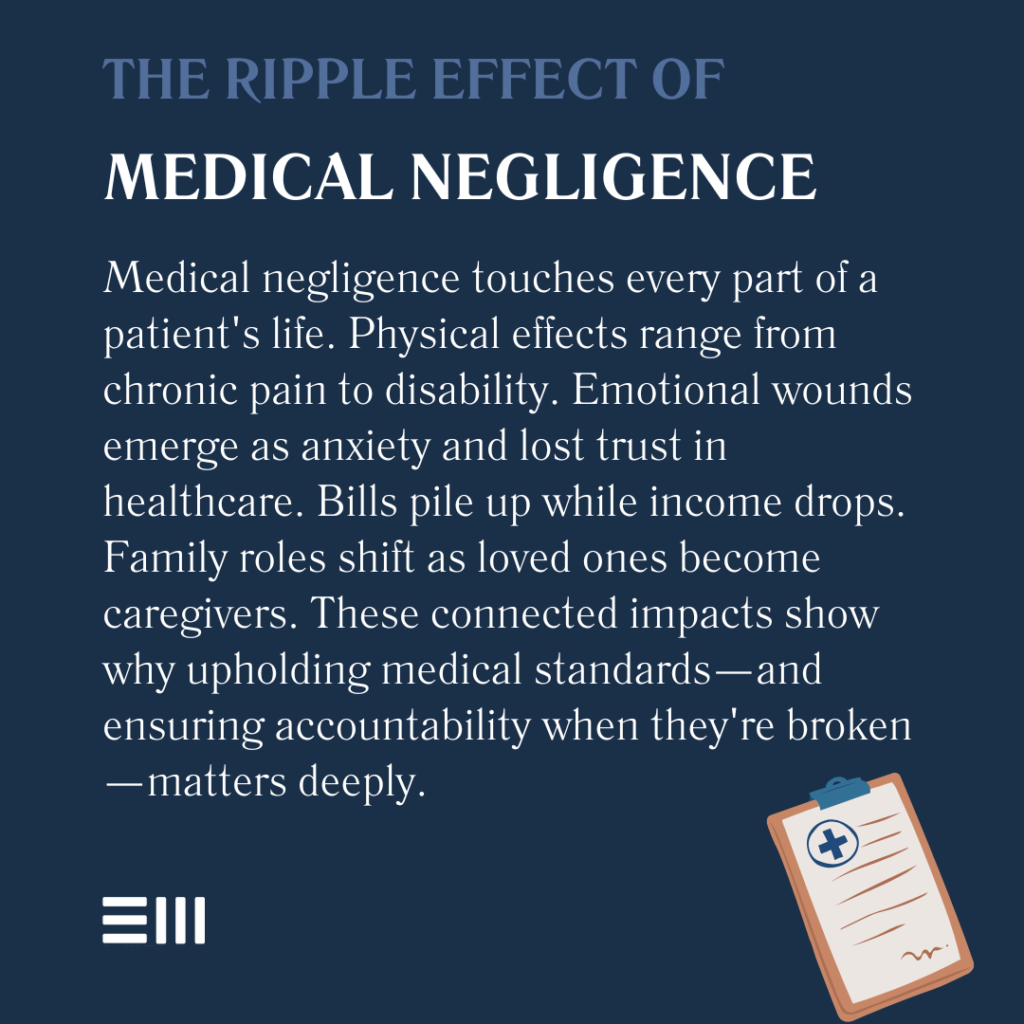
According to a Johns Hopkins study, medical errors are the third leading cause of death in the United States, claiming more than 250,000 lives annually.
Behind these statistics are real people whose lives have been forever changed by medical negligence.
Understanding the complexities of medical malpractice, particularly the standard of care and what constitutes negligence, can be the first step toward seeking justice and preventing future incidents.
Understanding Medical Standards of Care
The foundation of quality healthcare rests upon established standards that medical professionals must follow.
These standards represent the level and type of care that a reasonably competent healthcare provider, with similar training and experience, would deliver under comparable circumstances in the same community.
Medical standards of care encompass:
- Timely diagnosis and appropriate treatment plans;
- Proper medication management and administration;
- Regular monitoring of patient conditions;
- Clear communication with patients about treatment options;
- Adequate documentation of medical decisions and procedures; and
- Appropriate referrals to specialists when needed.
These standards evolve with medical advances and updated clinical guidelines, requiring healthcare providers to stay current with best practices in their field.
The standard of care may vary slightly between different medical specialties and geographic locations, but core principles remain consistent.
What Constitutes Medical Negligence?
Medical negligence occurs when healthcare providers fail to meet the established standard of care, resulting in patient harm.
This departure from acceptable medical practices can take various forms and occur at any stage of treatment.
Common examples of medical negligence include:
- Misdiagnosis or delayed diagnosis of serious conditions;
- Surgical errors or operating on the wrong body part;
- Medication errors, including incorrect dosage or drug interactions;
- Birth injuries resulting from improper delivery techniques;
- Failure to obtain informed consent before procedures;
- Laboratory errors or misinterpretation of test results;
- Premature discharge from medical facilities;
- Failure to order appropriate diagnostic tests;
- Inadequate follow-up care or monitoring; and
- Poor communication between healthcare providers.
Understanding the difference between unavoidable complications and true negligence requires careful evaluation of the circumstances and expert medical opinion.
Medical negligence can have devastating long-term consequences for patients and their families.
The Impact of Medical Negligence
When medical professionals breach the standard of care, the consequences can be far-reaching and devastating for patients and their families.
These impacts often include:
Physical Effects:
- Worsening of existing conditions;
- Development of new health problems;
- Permanent disability or impairment;
- Need for additional surgeries or treatments;
- Chronic pain or discomfort; and
- Reduced life expectancy.
Emotional and Psychological Effects:
- Depression and anxiety;
- Post-traumatic stress disorder (PTSD);
- Loss of trust in healthcare providers;
- Relationship difficulties;
- Reduced quality of life; and
- Mental anguish and emotional distress.
Financial Impact:
- Additional medical expenses;
- Lost wages and reduced earning capacity;
- Cost of ongoing care and rehabilitation;
- Medical equipment and home modifications;
- Transportation expenses for medical appointments; and
- Future medical care requirements.
Understanding these interconnected impacts helps patients and their families recognize the full scope of their damages when pursuing a medical malpractice claim.

Legal Elements of Medical Malpractice
To establish a valid medical malpractice claim in Alabama, several key elements must be proven:
- Existence of a doctor-patient relationship;
- Breach of the standard of care;
- Direct causation between the breach and injury; and
- Measurable damages resulting from the negligence.
Each element requires substantial evidence and expert testimony to demonstrate how the healthcare provider’s actions deviated from acceptable standards.
The complexity of these cases often necessitates extensive investigation and documentation.
The Role of Medical Experts
Medical experts play a crucial role in establishing malpractice claims by:
- Reviewing medical records and treatment decisions;
- Determining if the standard of care was breached;
- Establishing causation between negligence and injury;
- Providing expert testimony in legal proceedings;
- Assessing the long-term impact of injuries; and
- Calculating future medical needs and costs.
These experts must have relevant experience in the same field as the healthcare provider being evaluated and understand current medical standards and practices.
Critical Steps After Suspected Medical Negligence
Taking prompt action after suspecting medical negligence can significantly impact the outcome of your case.
Consider these essential steps:
- Obtain copies of all medical records and documentation;
- Document symptoms, complications, and conversations with medical staff;
- Seek immediate medical attention from another provider;
- Keep detailed records of additional expenses and losses;
- Maintain a journal of physical and emotional impacts;
- Contact an experienced medical malpractice attorney;
- Preserve all evidence related to medical care;
- Document all communication with healthcare providers;
- Take photographs of visible injuries or complications; and
- Keep receipts for all medical-related expenses.
Time is crucial, as Alabama has specific statutes of limitation for filing medical malpractice claims. Acting quickly helps preserve evidence and protect your legal rights.

The Legal Process for Medical Malpractice Claims
Understanding the legal process can help patients better prepare for their medical malpractice case:
Investigation Phase:
- Gathering medical records and evidence;
- Consulting with medical experts;
- Interviewing witnesses;
- Analyzing applicable medical standards; and
- Determining potential defendants.
Pre-litigation Steps:
- Filing notice of intent to sue;
- Obtaining expert certifications;
- Calculating damages;
- Attempting settlement negotiations; and
- Preparing legal documentation.
Litigation Process:
- Filing the lawsuit;
- Discovery phase;
- Depositions and expert testimony;
- Mediation attempts; and
- Trial preparation and proceedings.
Common Questions About Medical Malpractice in Alabama
Medical malpractice cases often raise numerous questions for affected patients and their families.
Here are answers to frequently asked questions we receive about medical malpractice in Alabama.
How Long Do I Have to File a Medical Malpractice Claim?
In Alabama, patients typically have two years from the date of injury to file a medical malpractice lawsuit. However, exceptions exist for cases involving the discovery of injury at a later date or cases involving minors.
How Can I Prove a Healthcare Provider Violated the Standard of Care?
Expert testimony from qualified medical professionals is essential. These experts review case details and testify about proper standards and how they were breached.
Documentation, medical records, and witness statements also play crucial roles in building evidence.
Does Every Medical Error Qualify as Malpractice?
Not all adverse medical outcomes result from negligence. The key is proving that the provider’s actions fell below the accepted standard of care and directly caused harm.
Some complications are known risks of medical procedures and may not constitute malpractice.
Protections Under Alabama Law
Alabama law provides specific protections for medical malpractice victims while also establishing important guidelines for cases:
Key Legal Provisions:
- Statute of limitations requirements;
- Expert witness qualifications;
- Damage caps and limitations;
- Notice requirements;
- Settlement procedures;
- Evidence standards; and
- Appeal rights.
Understanding these legal provisions helps patients protect their rights and pursue appropriate compensation for medical negligence.
Your Path to Justice Starts Here
When medical negligence impacts your life or the life of a loved one, you deserve dedicated legal support to help navigate the complex process of seeking justice.
Our experienced team understands the profound impact of medical malpractice and stands ready to evaluate your case.
Contact us today for a confidential consultation about your medical malpractice concerns.
Let our knowledge and resources work for you as we pursue the compensation and accountability you deserve.
Can't find what you're looking for? Search our site below.










